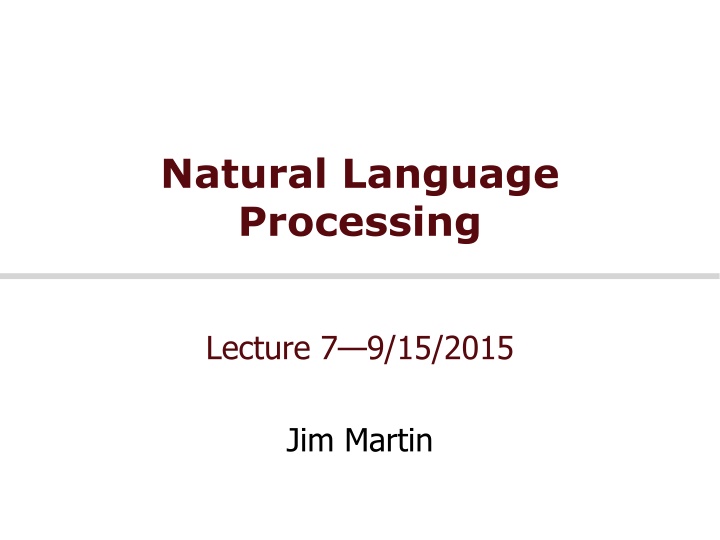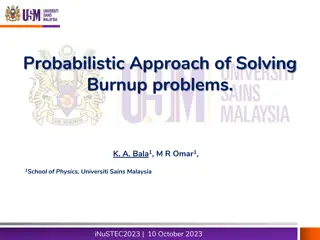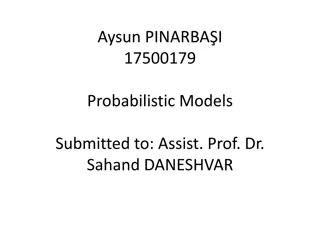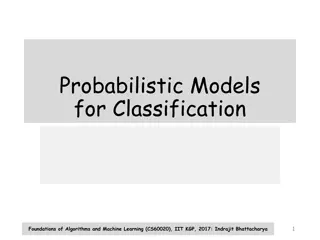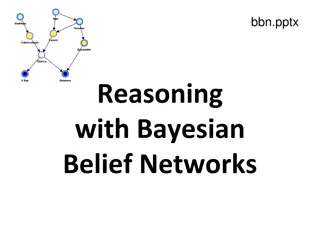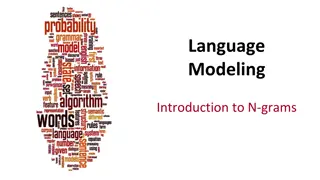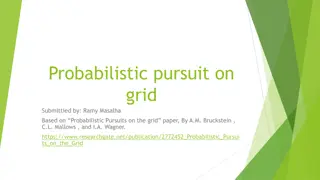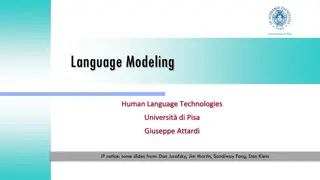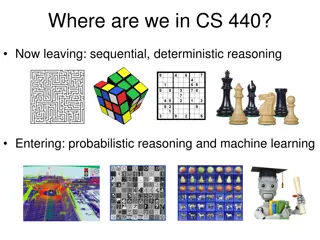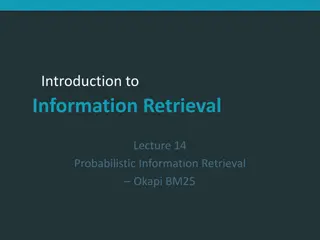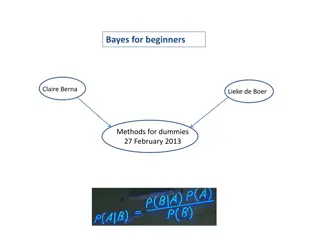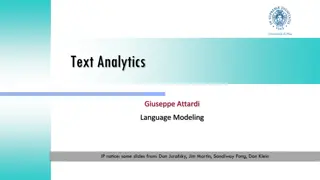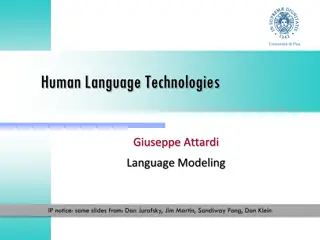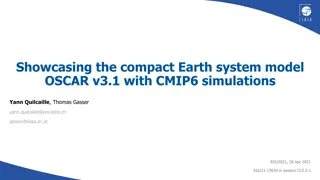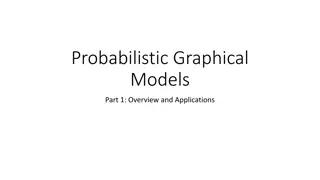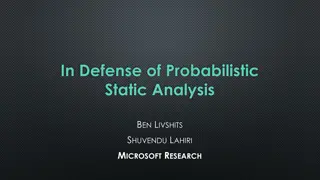Language Modeling: Probabilistic Model & Bigram Probabilities
In this lecture on natural language processing, the focus is on language modeling, probabilistic independence assumptions, smoothing techniques like Laplace smoothing, Markov assumption, bigram probabilities estimation, and perplexity. Jurafsky and Martin's "Speech and Language Processing" serves as a key reference throughout the presentation.
Download Presentation

Please find below an Image/Link to download the presentation.
The content on the website is provided AS IS for your information and personal use only. It may not be sold, licensed, or shared on other websites without obtaining consent from the author.If you encounter any issues during the download, it is possible that the publisher has removed the file from their server.
You are allowed to download the files provided on this website for personal or commercial use, subject to the condition that they are used lawfully. All files are the property of their respective owners.
The content on the website is provided AS IS for your information and personal use only. It may not be sold, licensed, or shared on other websites without obtaining consent from the author.
E N D
Presentation Transcript
Natural Language Processing Lecture 7 9/15/2015 Jim Martin
Today More language modeling Probabilistic model Independence assumptions Smoothing Laplace smoothing (add-1) Kneyser-Ney 2/25/2025 2 Speech and Language Processing - Jurafsky and Martin
Markov Assumption So for each component in the product replace with the approximation (assuming a prefix of N - 1) n-1) P(wn |wn-N+1 n-1 P(wn |w1 ) Bigram version n-1) P(wn|wn-1) P(wn|w1 2/25/2025 3 Speech and Language Processing - Jurafsky and Martin
Estimating Bigram Probabilities The Maximum Likelihood Estimate (MLE) P(wi|wi-1)=count(wi-1,wi) count(wi-1) 2/25/2025 4 Speech and Language Processing - Jurafsky and Martin
An Example <s> I am Sam </s> <s> Sam I am </s> <s> I do not like green eggs and ham </s> 2/25/2025 5 Speech and Language Processing - Jurafsky and Martin
Bigram Counts Vocabulary size is 1446 |V| Out of 9222 sentences Eg. I want occurred 827 times 2/25/2025 6 Speech and Language Processing - Jurafsky and Martin
Bigram Probabilities Divide bigram counts by prefix unigram counts to get bigram probabilities. 2/25/2025 7 Speech and Language Processing - Jurafsky and Martin
Bigram Estimates of Sentence Probabilities P(<s> I want english food </s>) = P(i|<s>)* P(want|I)* P(english|want)* P(food|english)* P(</s>|food)* =.000031 2/25/2025 8 Speech and Language Processing - Jurafsky and Martin
Perplexity Perplexity is the probability of a test set (assigned by the language model), as normalized by the number of words: Chain rule: For bigrams: Minimizing perplexity is the same as maximizing probability The best language model is one that best predicts an unseen test set 2/25/2025 9 Speech and Language Processing - Jurafsky and Martin
Lower perplexity means a better model Training 38 million words, test 1.5 million words, WSJ 2/25/2025 10 Speech and Language Processing - Jurafsky and Martin
Practical Issues Once we start looking at test data, we ll run into words that we haven t seen before. Standard solution Given a corpus Create an unknown word token <UNK> Create a fixed lexicon L, of size V From a dictionary or A subset of terms from the training set At text normalization phase, any training word not in L is changed to <UNK> Collect counts for that as for any normal word At test time Use UNK counts for any word not seen in training 2/25/2025 11 Speech and Language Processing - Jurafsky and Martin
Practical Issues Multiplying a bunch of small numbers between 0 and 1 is a really bad idea Multiplication is slow And underflow is likely So do everything in log space Avoid underflow Adding is faster than multiplying 2/25/2025 12 Speech and Language Processing - Jurafsky and Martin
Smoothing Back to Shakespeare Recall that Shakespeare produced 300,000 bigram types out of V2= 844 million possible bigrams... So, 99.96% of the possible bigrams were never seen (have zero entries in the table) Does that mean that any sentence that contains one of those bigrams should have a probability of 0? For generation (shannon game) it means we ll never emit those bigrams But for analysis it s problematic because if we run across a new bigram in the future then we have no choice but to assign it a probability of zero. 2/25/2025 13 Speech and Language Processing - Jurafsky and Martin
Zero Counts Some of those zeros are really zeros... Things that really aren t ever going to happen On the other hand, some of them are just rare events. If the training corpus had been a little bigger they would have had a count What would that count be in all likelihood? Zipf s Law (long tail phenomenon): A small number of events occur with high frequency A large number of events occur with low frequency You can quickly collect statistics on the high frequency events You might have to wait an arbitrarily long time to get valid statistics on low frequency events Result: Our estimates are sparse! We have no counts at all for the vast number of things we want to estimate! Answer: Estimate the likelihood of unseen (zero count) N-grams! 2/25/2025 14 Speech and Language Processing - Jurafsky and Martin
Laplace Smoothing Also called Add-One smoothing Just add one to all the counts! Very simple MLE estimate: Laplace estimate: 2/25/2025 15 Speech and Language Processing - Jurafsky and Martin
Bigram Counts 2/25/2025 16 Speech and Language Processing - Jurafsky and Martin
Laplace-Smoothed Bigram Counts 2/25/2025 17 Speech and Language Processing - Jurafsky and Martin
Laplace-Smoothed Bigram Probabilities 2/25/2025 18 Speech and Language Processing - Jurafsky and Martin
Reconstituted Counts 2/25/2025 19 Speech and Language Processing - Jurafsky and Martin
Reconstituted Counts (2) 2/25/2025 20 Speech and Language Processing - Jurafsky and Martin
Big Change to the Counts! C(want to) went from 608 to 238! P(to|want) from .66 to .26! Discount d= c*/c d for chinese food =.10!!! A 10x reduction So in general, Laplace is a blunt instrument Could use more fine-grained method (add-k) Because of this Laplace smoothing not often used for language models, as we have much better methods Despite its flaws Laplace (add-1) is still used to smooth other probabilistic models in NLP and IR, especially For pilot studies In document classification In domains where the number of zeros isn t so huge. 2/25/2025 21 Speech and Language Processing - Jurafsky and Martin
Better Smoothing Two key ideas Use less context if the counts are missing for longer contexts Use the count of things we ve seen once to help estimate the count of things we ve never seen 2/25/2025 22 Speech and Language Processing - Jurafsky and Martin
Backoff and Interpolation Sometimes it helps to use less context Condition on less context for contexts you haven t learned much about Backoff use trigram if you have good evidence, otherwise bigram, otherwise unigram Interpolation mix unigram, bigram, trigram Interpolation works better
Linear Interpolation Simple interpolation Lambdas conditional on context
How to set the lambdas? Use a held-out corpus Held- Out Data Test Data Training Data Choose s to maximize the probability of held-out data: Fix the N-gram probabilities (using the training data) Then search for s that give largest probability to held-out set.
Types, Tokens and Fish Much of what s coming up was first studied by biologists who are often faced with 2 related problems Determining how many species occupy a particular area (types) And determining how many individuals of a given species are living in a given area (tokens) 2/25/2025 26 Speech and Language Processing - Jurafsky and Martin
One Fish Two Fish Imagine you are fishing There are 8 species: carp, perch, whitefish, trout, salmon, eel, catfish, bass Not sure where this fishing hole is... You have caught up to now 10 carp, 3 perch, 2 whitefish, 1 trout, 1 salmon, 1 eel = 18 fish How likely is it that the next fish to be caught is an eel? How likely is it that the next fish caught will be a member of newly seen species? Now how likely is it that the next fish caught will be an eel? Speech and Language Processing - Jurafsky and Martin Slide adapted from Josh Goodman 2/25/2025 27
Fish Lesson We need to steal part of the observed probability mass to give it to the as yet unseen N-Grams. Questions are: How much to steal How to redistribute it 2/25/2025 28 Speech and Language Processing - Jurafsky and Martin
Absolute Discounting Just subtract a fixed amount from all the observed counts (call that d). Redistribute it proportionally based on observed data 2/25/2025 29 Speech and Language Processing - Jurafsky and Martin
Absolute Discounting w/ Interpolation discounted bigram Interpolation weight PAbsoluteDiscounting(wi|wi-1)=c(wi-1,wi)-d +l(wi-1)P(w) c(wi-1) unigram 30
Kneser-Ney Smoothing Better estimate for probabilities of lower-order unigrams! Shannon game: I can t see without my reading___________? Francisco is more common than glasses but Francisco frequently follows San So P(w) isn t what we want Francisco glasses
Kneser-Ney Smoothing Pcontinuation(w): How likely is w to appear as a novel continuation? For each word, count the number of bigram types it completes PCONTINUATION(w) {wi-1:c(wi-1,w)>0} 2/25/2025 32 Speech and Language Processing - Jurafsky and Martin
Kneser-Ney Smoothing Normalize by the total number of word bigram types to get a true probability {wi-1:c(wi-1,w)>0} {(wj-1,wj):c(wj-1,wj)>0} PCONTINUATION(w)=
Kneser-Ney Smoothing PKN(wi|wi-1)=max(c(wi-1,wi)-d,0) +l(wi-1)PCONTINUATION(wi) c(wi-1) is a normalizing constant; the probability mass we ve discounted d l(wi-1)= {w:c(wi-1,w)>0} c(wi-1) The number of word types that can follow wi-1 the normalized discount 34
